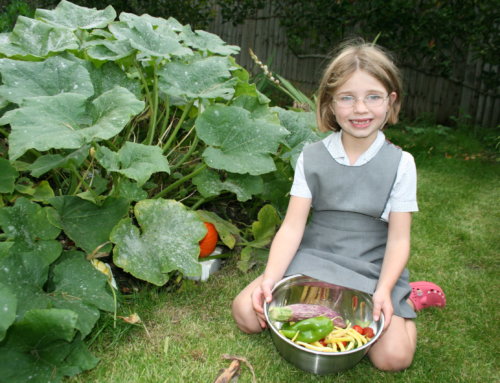Allotment Gardening by Susan Berger (with drawings by Jennifer Johnson and photographs by Nicola Browne) Published by Green Books (www.greenbooks.co.uk)
If you’re interested in starting to grow your own fruit and veg for the first time, or wish to experiment with things you’ve never tried before, I can think of no better book to recommend than this one. It gives you easy instructions on how to get going and what you’ll need. Tucked away in the list of useful items is a fold up chair – “a picnic chair is great for a tea break.” The Tea Break Gardener thoroughly approves of this sentiment.
I’m so glad I bought this book as I came upon it by chance on a garden centre book display. I’d made the error of going on a bank holiday and was queuing up behind trolleys crammed with bedding plants and frustrated punters. I picked it up, flicked through, and put it in my trolley on impulse as the queue shuffled forwards.
This is a handy book to have on you at each stage as you plan and grow, harvest and eat. I refer to it when looking at seed catalogues and choosing what to grow, when I’m planning where to grow each thing, when I need to know how far apart to space things etc. Unsurprisingly my copy has muddy fingermarks all over it. When I first set up my veg patch it accompanied me outside to save me running indoors when I’d forgotten what to do.
Don’t let the title ‘Allotment Gardening’ put you off if you don’t have an allotment. The beauty of this book is that it’s an A-Z of Vegetables, Fruit, Herbs and Flowers and gives you individual sections on how to grow each one. Whatever space you have, this book is your ideal ready reckoner as you experiment over the years.
For each plant, the text is split for easy reference into sections. These include ‘When to Plant’, ‘Where to sow’, ‘cultivation’ techniques, ‘harvesting and storing’ and ‘pests and diseases’. It also suggests varieties to try and even has suggested recipes. The link between growing and eating is important and I believe the author meant to gently remind the gardener of this. There is a joy in growing, but growing food then wasting it is surely a horticultural sin.
Sage advice, that I first read here and have adopted as a mantra, is to grow things that are comparatively expensive to buy, examples being celeriac or raspberries. Growing unusual varieties unavailable in the shops is also recommended.
The inside of this book is simple but truly beautiful . There are a few well-shot colour plates but charmingly, each plant is simply accompanied by a pretty pencil sketch. The words are so good that ‘how to’ illustrations are just not needed. It’s the sign of a good garden writer
Particularly useful for anyone actually taking on an allotment are the front sections titled ‘Getting Started’. These give you an honest appraisal of what to expect in terms of the grow-your-own lifestyle. It’s honest about the challenges you’ll face in terms of site preparation, time-constraints and of course weeds, pests and diseases. It outlines the basics of composting, crop rotation, growing from seed and design.



